Amy Millios
Hanover, New Hampshire, United States
 |
| Giant’s Heart, St. Michael’s Mount – Cornwall, June 2014, Amy Millios |
For the past few years I’ve had a real knack for finding heart-shaped things while roaming in the great outdoors. And while it’s mostly been stones, during last year’s trip to Cornwall I started seeing hearts everywhere, both outside and in. Was it a result of Zen eye or were they a sign of some kind?
I found a heart-shaped stone my first day on Penzance Beach with flecks of orange and red. It fit in the palm of my hand and seemed to send out a delicious, gentle heat that chased away the chill of the wind. Whether the heat was real or imagined, I liked the stone—its hardness with invisible fire. A few days later a white one called out to me as I walked the coastal path to Mousehole; the heart shape was more subtle but still clear to me, and it offered a vague impression of a human face—eyes, nose, mouth.
One night as I sat waiting for my dinner at The Turk’s Head Pub I ordered a pint of the house ale—a rich, golden brown, with a half inch of light creamy foam on the top, and a slight bitterness that went away after the first few sips. By the end of my fish and chips and home mushed peas some of the foam had slid down the glass. In surprise and delight, I laughed out loud and snapped photos with my iPhone in order to preserve the evidence. My laughing and snapping drew looks from the other patrons, but the shape was clear. The foam had formed a heart.
Then there was the so-called Giant’s Heart at St. Michael’s Mount in Marazion, laid within the cobbles tourists walk over during their climb to the castle. It took me a long while to find it. Every twenty minutes on the village green visitors to the island are treated to a dramatic retelling of how Jack blew his horn and woke the wicked giant Cormoran. Angry and stunned with the sun in his eyes, he fell off the summit and down into a pit Jack had dug, never to bother the villagers again. The Giant’s burial was swift, but his heart was put on display. Once I found the stone I couldn’t stop taking photos. It was bigger than any other heart-shaped stone I had encountered before, closer to human size. I wanted to hold it in my hands. Since I had to settle for kneeling beside it I traced its curves, thinking about my seaside vacation’s string of hearts. And that perhaps my doctor got the diagnosis wrong, that the medical tale she had spun from my symptoms was as tall as that of Jack and Cormoran.
When I got back to my room at the B and B the reverie broke when I signed onto Facebook. Two women in their twenties had just died from heart disease, a complication from many years of battling rheumatoid arthritis. Twenty-somethings. I am nearly 40 and have been living with a different type of autoimmune arthritis, but struggling all the same to keep my spine as supple as possible, my hips and knees moving. My Achilles tendons swell at the least provocation. And my heart is a rapid beater, routinely skipping and pounding at 120 beats per minute as I sit, sometimes more. I was put on the watch list early on in my diagnosis, subjected to countless EKGs and echocardiograms, all the better to be on top of any nefarious structural changes or lethal rhythm disturbances than be surprised. The crushing fatigue I experience on a daily basis may be a result of the ungodly amount of inflammation circulating in my body, the chronic pain itself, or this highly inefficient heartbeat of mine. Regardless, the result is fear; worry in the form of staring at the ceiling in the dark, one or both hands on my chest feeling for my heartbeat, making sure I’m still alive.
Every five weeks I curl up in a recliner in the hospital chemotherapy suite for three hours. The Remicade that drips into my vein does help some with the back pain, but it can also cause all sorts of cancers and actually kill me during the infusion if I’m ever unlucky enough. And I don’t want to think about that. At the 30-minute mark I normally succumb to the Benadryl, drifting off to the intermittent fluttery pops in my chest as I watch how light shines through the $10,000 bag of poison.
I hold the two heart-shaped stones in my hand as if amulets. I’m not ready for my heart to stop. I think back to when my grandfather died and how I watched his heart beat on the screen for hours after the ventilator was pulled. Hours. His heart beat at an incredible clip for hours. And then I saw it stop. Whatever may or may not happen with my own heart, I remind myself that I genetically inherited that same strength and will to live. I am reminded by the heart-shaped stones in the palm of my hand—the hardness with invisible fire, the face.
AMY MILLIOS is working on her MA in Creative Writing at Dartmouth College and through her work aims to draw attention to the patient experience of chronic illness. This past October she attended the American College of Rheumatology’s Advocates for Arthritis conference in Washington, D.C.and spent time on Capitol Hill advocating on behalf of legislation to benefit those with rheumatic diseases. Her oral history project “Making the Invisible Visible: Women’s Stories of Living With Ankylosing Spondylitis” was published in the fall 2015 edition of the Dartmouth College Oral History Reader. Her photography has been featured in literary journals.
Spring 2016 | Sections | Personal Narratives

Leave a Reply